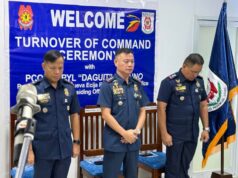Artist Willy Layug presents clay model of the Crucified Christ at his studio.
Photos by Bong Lacson
CITY OF SAN FERNANDO – Mater Dolorosa in Filipiniana. Crucified Christ in excruciating pain. Two life-size images that will share center stage with Pope Francis in his visit to the country early next year.
No, make that three – with an altar crucifix that shall be in all the Masses the pontiff will celebrate. All in the process of being crafted by foremost sculptor Willy Layug of Betis, Guagua, Pampanga.
A Presidential Merit Awardee for Ecclesiastical Art, Layug has been asked by the archdioceses of Manila and Palo, Leyte to sculpt images of the Virgin Mary and the Crucified Christ specifically for the papal visit. At no cost to the Church.
“Gratis et amore,” said Layug. “The blessings from the Almighty that shall pour upon our land with the coming of His Holiness is much, much more than any material reward for my work.” While the particular images were prescribed by Church officials, the interpretation is totally left to Layug’s creative genius.
The local color on the Mater Dolorosa goes beyond the Filipiniana dress and her Malay features. Teardrops, a signature hallmark of the image, will be limited to three to represent the country’s main islands of Luzon, Visayas and Mindanao.
From local, the image goes international with the globe upon which the Virgin stands, traditionally covered with clouds, is now buffeted by waves – “representative of the storm surge that devastated Leyte, as well as the threat of global warming and climate change,” said Layug.
The infusion of the Mother of Perpetual Help icon into Layug’s Mater Dolorosa interpretation comes in the young Jesus cradled in her arm – “tightly holding her hand, one sandal slipping off his foot, looking down as though in fright of the tidal waves about to engulf the children of Leyte.”
The seven-foot image – inclusive of its base – will be installed at the Palo Metropolitan Cathedral for the papal Mass.
The Crucified Christ image will hew closely to historical records of actual crucifixions at the time of the Roman Empire. “There will be ropes to support the body, the way it was done in those times, as studies show,” said Layug.
The image will be five feet and nine inches in height. A break from the traditional representation of the Crucified Christ – with stretched bloodied legs and one foot nailed over the other – in Layug’s interpretation is that one leg is bent at the knee and the feet nailed separately.
“Pain at its most excruciating level is evoked there,” Layug said. The Crucified Christ image will provide the backdrop in the pontifical Mass in Manila. Both images of the Mater Dolorosa and the Crucified Chirst have already been modelled in clay, with the former having already a finished smaller version in wood and its full size already 50 percent sculpted.
To accompany Pope Francis in all his Masses in the country will be the altar crucifix Layug has yet to model in clay.
“I am thinking of that instant right after the Lord uttered ‘It is consummated’ as my representation of the image,” said Layug. The crucifix will not be taller than two feet including base, he added.
Kapampangan pride
Having been chosen by the Church to craft the religious images exclusive to the papal visit is “first and foremost a blessing, and second, a celebration of Kapampangan artistry and ingenuity.” “It’s not all about me, the sculptor. My name may not even merit a line in the news accounts.
It is all about our deep faith as a people, as Kapampangans and our art and culture,” said Layug. He furthered: “It will go a long way too in inspiring our young artists and artisans, particularly here in Betis, to take to their mallets and chisels with more vigor and enthusiasm to revive our art and livelihood and take it to even greater heights of glory as well as productivity.”
Once the town’s most thriving enterprise, woodcarving – a heritage industry passed on from generation to generation – has contracted with local folk seeking other “easier and more financially rewarding” means of livelihood.
Layug’s advocacy of the preservation and promotion of the woodcarving industry, dubbed at its height as “Betis Baroque” gained national and international attention with masterpieces like the restored Matamoros on the pediment of the Intramuros Gate, the baldacchino of the Sto. Domingo Church, and retablos of some of the country’s major cathedrals and churches.
Layug’s opus has found a niche in Rome itself – the San Lorenzo Ruiz and San Pedro Calungsod altar at the Pontificio Collegio Filippino which sawali and bamboo designs highlight its unique Filipino character.



